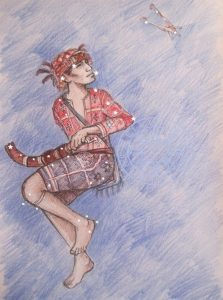By Bridgette Diaz

Magbangal, Bukidnon’s version of Orion.
Artwork by Ged Alangui.
Despite being devoted to the rigorous, disciplined, systematic, and scientific study of Western astrology, Astrology Friends Philippines asserts the beauty and the importance of Filipino indigenous astrology. Philippine astrological traditions must be recognized and studied for the good of Filipino culture—preserving its originality and the unique backgrounds and histories it carries with it—and for the good of astrology—showing that “as above, so below” traverses cultures and time periods.
As a product of its critical and principled approach to astrology, Filipino Astrologer Resti Santiago, together with the rest of AstroFriends, launched a project where several artists were commissioned to illustrate indigenous constellations aiming to bring these stellar images to life. The first batch was the Tiruray Zodiac drawn by pencil by Jet Bernal in 2013. The second batch was done in color by Baguio-based artist Ged Alangui.
There are excellent pieces of literature on Filipino star lore. For example, the ancient Filipinos’ use of the stars was discussed extensively by Dante Ambrosio in his book Balatik. According to Ambrosio, ancient Filipinos used constellations and planets to mark the beginning of certain activities such as starting an alliance and warfare, performing rituals or reciting prayers, and conducting weddings. However, as discussed by Ambrosio, the main importance of the constellations and planets to the ancient Filipinos was mainly for agricultural purposes and this could not be truer in the Bukidnon’s use of the constellation Orion.
Magbangal was a great hunter who possessed magical hatchets and bolos and hunted wild boars for food. One day, near the planting season, Magbangal thought that their field needed to be cleared and set out to do just that the following day. Magbangal relayed this to his wife. Both worried and curious, his wife asked if she could go with him, but Magbangal replied that he preferred to work alone and advised her wife to stay home.
Upon reaching the field, Magbangal made a small bench to rest on and instructed his magical hatchets and bolos to sharpen themselves and start clearing bushes, shrubs, and trees. After giving the order, Magbangal went to sleep. His wife at home heard the trees falling and noticed that the field was being cleared very fast, making her think that Magbangal had others helping him out. To verify this, his wife went to the field and was astonished that the hatchets and the bolos were cutting bushes and trees with no hands guiding.
Magbangal woke up at the feeling that someone was watching him. Unfortunately, as he jolted up, his arm was cut off accidentally by a hatchet. He saw his wife hiding behind the tree. Immediately, Magbangal went home. Later on, he expressed that he felt it would be better for him to be up in the sky, so he could signal to people when it would be a good time to start planting. Afterward, he instructed his wife to go to the river and become a fish.
Magbangal in the astrology of Bukidnon, according to Ambrosio’s Balatik, is Orion. Like Orion, Magbangal’s myths describe him as a powerful hunter. On the other hand, the anthropologist Fay-Copper Cole identifies Magbangal as Ursa Majora—a huntress turned bear. The mythical associations vary among different scholars, but one thing shared in common is that the associated constellations were often related to agriculture—its position in the night sky being highly important in marking the schedule of an agricultural practice.
In particular, the Bukidnon’s use of Magbangal’s position in the night sky is to indicate the climate for the period. As described by Cole, Magbangal’s (Orion/Ursa Major) rising early evening indicates the Cold-Dry season, its culmination indicates the Hot-Dry season, and its setting indicates the increase in Humidity that signifies the approaching rainy season. With this, the Bukidnon aligned their agricultural activity in accordance with the climate. For Cold-Dry season, Magbangal rises in the early evening, mid-December, signifying the start of the clearing of fields after harvest. Given that the weather is dry and cold, this makes practical sense. In addition, the nights are longer which is not good for planting, and weeds during this period appear to grow slowly. During the times that Magbangal culminates early in the evening, the weather in the country is hot and dry. With longer days and dry warmth, it becomes ideal for the Bukidnon’s to do their Kaingin. The ashes of the burned weeds and dead trees help in fertilizing the land, preparing the soil for planting. Lastly, when Magbangal sets early in the evening, indicating the increasing humidity which signifies the rainy season, planting is favorable. The rain moisture nourish the seeds that have been sown.
The knowledge of the stars as told through mythologies passed onto different generations and civilizations brought about certain belief systems that served as explanations for things that are unknown, fascinating, and terrifying to the ancient man. With this came the traditions, practices, and norms used by man to instill order, control chaos, and maximize his environment. The myth of Magbangal and its application by the Bukidnon’s in their agricultural practices is a testament to this. With the lack of instrumentation to predict weather and climate, the Bukidnons were wise enough to utilize the stars as markers. The source of their knowledge is still a mystery and thus requires further study and research. None the less, the fact that the Bukidnon’s use of stars to predict the best time to do their agricultural activities is an amazing feat—an achievement of the ancient Filipino civilization as a whole.
Based on the original article written by Emmanuel Salas published in Medieval Astro-Clock 2014.
